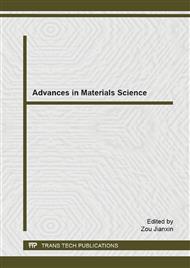[1]
R. J. Dinis-Oliveira, J. A. Duarte, A. Sanchez-Navarro, F. Remiao, M. L. Bastos, F. Carvalho, Paraquat poisonings: mechanisms of lung toxicity, clinical features, and treatment, Crit. Rev. Toxicol. 38 (2008) 13-71.
DOI: 10.1080/10408440701669959
Google Scholar
[2]
M. Tuzen, M. Soylak, Multiwalled carbon nanotubes for speciation of chromium in environmental samples, J. Hazard. Mater. 147 (2007) 219-225.
DOI: 10.1016/j.jhazmat.2006.12.069
Google Scholar
[3]
O. Ozcan, I. Inci, Y. S. Asçi, Multiwall Carbon Nanotube for Adsorption of Acetic Acid, J. Chem. Eng. Data 58 (2013) 583-587.
DOI: 10.1021/je301064t
Google Scholar
[4]
M. Ghaedi, A. Shokrollahi, H. Hossainian, S. N. Kokhdan, Comparison of Activated Carbon and Multiwalled Carbon Nanotubes for Efficient Removal of Eriochrome Cyanine R (ECR): Kinetic, Isotherm, and Thermodynamic Study of the Removal Process, J. Chem. Eng. Data 56 (2011).
DOI: 10.1021/je200331u
Google Scholar
[5]
M. Ghaedi, A. Hassanzadeh, S. N. Kokhdan, Multiwalled Carbon Nanotubes as Adsorbents for the Kinetic and Equilibrium Study of the Removal of Alizarin Red S and Morin, J. Chem. Eng. Data 56 (2011) 2511-2520.
DOI: 10.1021/je2000414
Google Scholar
[6]
X. Li, H. Zhao, X. Quan, S. Chen, Y. Zhang, H. Yu, Adsorption of ionizable organic contaminants on multi-walled carbon nanotubes with different oxygen contents, J. Hazard. Mater. 186 (2011) 407-415.
DOI: 10.1016/j.jhazmat.2010.11.012
Google Scholar
[7]
O. Yavuz, Y. Altunkaynak, F. Guzel, Removal of Copper, Nickel, Cobalt and Manganese from Aqueous Solution by Kaolinite, Water Res. 37 (2003) 948-952.
DOI: 10.1016/s0043-1354(02)00409-8
Google Scholar
[8]
Y. S. Ho, G. McKay, Kinetic Models for the Sorption of Dye from Aqueous Solution by Wood, Process Saf. Environ. Protect 76 (1998) 183-191.
DOI: 10.1205/095758298529326
Google Scholar
[9]
H. B. Senturk, D. Ozdes, A. Gundogdu, C. Duran, M. Soylak, Removal of phenol from aqueous solutions by adsorption onto organomodified Tirebolu bentonite: Equilibrium, kinetic and thermodynamic study, J. Hazard. Mater. 172 (2009) 353-362.
DOI: 10.1016/j.jhazmat.2009.07.019
Google Scholar
[10]
H.M.F. Freundlich, Over the adsorption in the solution, Zeitschriftfür Physikalische Chemie. 57 (1906) 385-470.
Google Scholar
[11]
N. K. Amin, Removal of direct blue-106 dye from aqueous solution using new activated carbons developed from pomegranate peel: Adsorption equilibrium and kinetics, J. Hazard. Mater. 165 (2009) 52-62.
DOI: 10.1016/j.jhazmat.2008.09.067
Google Scholar
[12]
A. S. Ozcan, A. Ozcan, Adsorption of acid dyes from aqueous solutions onto acid-activated bentonite. J. Colloid Interface Sci. 276 (2004) 39-46.
DOI: 10.1016/j.jcis.2004.03.043
Google Scholar


